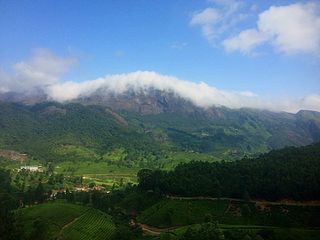
The Western Ghats, also known as the Sahyadri mountain range, is a mountain range that covers an area of 160,000 km2 (62,000 sq mi) in a stretch of 1,600 km (990 mi) parallel to the western coast of the Indian peninsula, traversing the states of Gujarat, Maharashtra, Goa, Karnataka, Kerala and Tamil Nadu. It is a UNESCO World Heritage Site and is one of the 36 biodiversity hotspots in the world. It is sometimes called the Great Escarpment of India. It contains a very large proportion of the country's flora and fauna, many of which are endemic to this region. The Western Ghats are older than the Himalayas. They influence Indian monsoon weather patterns by intercepting the rain-laden monsoon winds that sweep in from the south-west during late summer. The range runs north to south along the western edge of the Deccan Plateau and separates the plateau from a narrow coastal plain called the Western Coastal Plains along the Arabian Sea. A total of 39 areas in the Western Ghats, including national parks, wildlife sanctuaries and reserve forests, were designated as world heritage sites in 2012 – twenty in Kerala, ten in Karnataka, six in Tamil Nadu and four in Maharashtra.
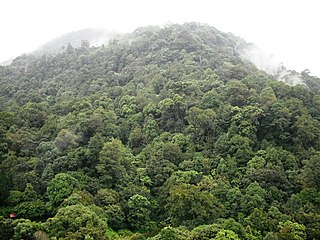
The South Western Ghats montane rain forests is an ecoregion in South India, covering the southern portion of the Western Ghats in Karnataka, Kerala and Tamil Nadu at elevations from 1,000 to 2,695 m. Annual rainfall in this ecoregion exceeds 2,800 mm (110 in).

The Malabar large-spotted civet, also known as the Malabar civet, is a viverrid endemic to the Western Ghats of India. It is listed as Critically Endangered on the IUCN Red List as the population is estimated to number fewer than 250 mature individuals. It has not been recorded during surveys carried out between 1990 and 2014. In the early 1990s, isolated populations still survived in less disturbed areas of South Malabar but were seriously threatened by habitat destruction and hunting outside protected areas.

Mudumalai National Park is a national park in the Nilgiri Mountains in Tamil Nadu in southern India. It covers 321 km2 (124 sq mi) at an elevation range of 850–1,250 m (2,790–4,100 ft) in the Nilgiri District and shares boundaries with the states of Karnataka and Kerala. A part of this area has been protected since 1940. The national park has been part of Nilgiri Biosphere Reserve since 1986 and was declared a tiger reserve together with a buffer zone of 367.59 km2 (141.93 sq mi) in 2007. It receives an annual rainfall of about 1,420 mm (56 in) and harbours tropical and subtropical moist broadleaf forests with 498 plant species, at least 266 bird species, 18 carnivore and 10 herbivore species. It is drained by the Moyar River and several tributaries, which harbour 38 fish species.
The term Malabar rainforests refers to one or more distinct ecoregions recognized by biogeographers:
- the Malabar Coast moist forests formerly occupied the coastal zone to the 250 metre elevation
- the South Western Ghats moist deciduous forests grow at intermediate elevations
- the South Western Ghats montane rain forests cover the areas above 1000 metres elevation
Elaeocarpus blascoi is a species of flowering plant in the Elaeocarpaceae family. It is endemic to the Western Ghats of southern India, It is threatened by habitat loss and is Critically Endangered.
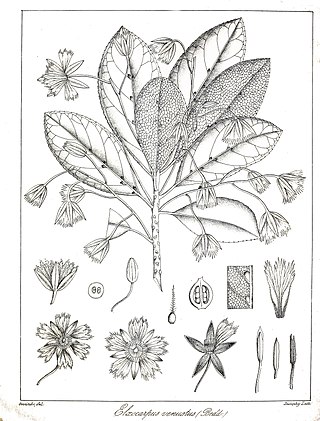
Elaeocarpus venustus is a species of flowering plant in the Elaeocarpaceae family. It is found only in the Western Ghats of Tamil Nadu state in southern India. It is Critically Endangered, and threatened by habitat loss.
Actinodaphne lawsonii is a species of plant in the family Lauraceae. It is endemic to the Western Ghats of southern India. It is threatened by habitat loss.

Goniothalamus wynaadensis is a species of plant in the Annonaceae family. It is endemic to the Western Ghats of southern India.

Palaquium ravii is a species of tree in the family Sapotaceae. It is endemic to the Western Ghats mountains and native to Kerala and Tamil Nadu in India.

Phyllanthus anamalayanus is a species of plant in the family Phyllanthaceae. It is endemic to the Anamalai Hills in Coimbatore district in the state of Tamil Nadu, India. The species is a shrub or small tree occurring in the understorey of mid-elevation tropical wet evergreen forests in the Anamalai Hills, and is endemic to the Western Ghats. It is threatened by habitat loss.

Syzygium densiflorum is a species of evergreen tree in the family Myrtaceae. It is endemic to the Western Ghats mountains, India. The species is categorised as Vulnerable in the IUCN Red List.

Vateria indica, the white dammar, is a species of tree in the family Dipterocarpaceae. It is endemic to the Western Ghats mountains in India. It is threatened by habitat loss. It is a large canopy or emergent tree frequent in tropical wet evergreen forests of the low and mid-elevations.
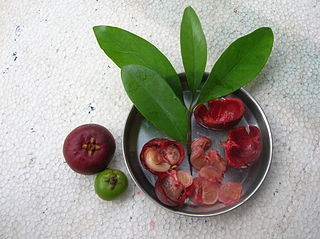
Garcinia indica, a plant in the mangosteen family (Clusiaceae), commonly known as kokum, is a fruit-bearing tree that has culinary, pharmaceutical, and industrial uses. It primarily grows in the Western Ghats, especially the Goa and Konkan region.

Garcinia pushpangadaniana is a tree species in the family Clusiaceae. It was described in 2013 from a population found in the southern part of the Western Ghats in India. The specific epithet of this species honors Dr. P. Pushpangadan, former Director of Jawaharlal Nehru Tropical Botanical Garden & Research Institute.
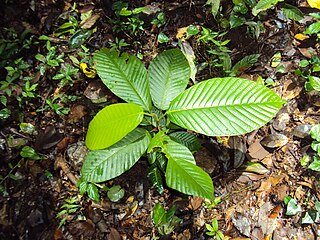
Dipterocarpus bourdillonii is a species of large tree in the family Dipterocarpaceae endemic to the Western Ghats principally in the state of Kerala in India. It is a Critically Endangered species according to the IUCN Red List of Threatened Species. It is a characteristic tree of the low-elevation tropical wet evergreen rainforests in the Western Ghats.

Garcinia pseudoguttifera, known as the mo'onia tree in its native range, is a species of flowering tree in the family Clusiaceae or Guttiferae.
Garcinia magnifolia, also known as bebasajo or giant leaf madrono, is a flowering tree in the family Clusiaceae or Guttiferae.

Garcinia talbotii is a large tree in the family Clusiaceae and is endemic to the Western Ghats of India. The tree has yellow latex, and can attain a height of 25 m and girth up to 2.2 m. This species was first reported from Gairsoppah Ghats in North Kanara of Karanataka district.
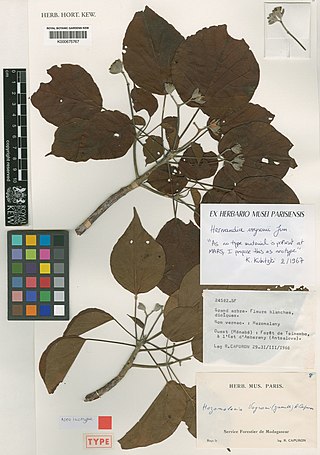
Hernandia voyronii, commonly known as Hazomalany, is a species of plant in the Hernandiaceae family. It is endemic to Madagascar.
















